This is the fourth and final piece in a ThinkProgress series chronicling the struggles of immigrant life in Southern California along the U.S.-Mexico border. You can find our other pieces here, here, and here.
SAN DIEGO, CA — It was hard not to think about death in the Jacumba desert. Hot, bleak, and desolate, the dry air and glaring lack of life created a palpable sense of foreboding when ThinkProgress visited last October. It was also eerily quiet, with only a few sounds puncturing the stillness: the rustle of the wind as it swept over the rocky peaks in the distance; the crunch of footsteps as we ambled across the sea of baked sand; the uneven sloshing of the water jugs we held in our hands.
And, of course, the soft hum of two large Border Patrol SUVs perched on the crest of the nearby hill.
“They won’t do anything to us,” said Enrique Morones, our guide for the day and head of Border Angels, a local immigration advocacy group. He turned and waved at the officers up the hill. “Now, if we were jumping the fence over here, that would be different…”
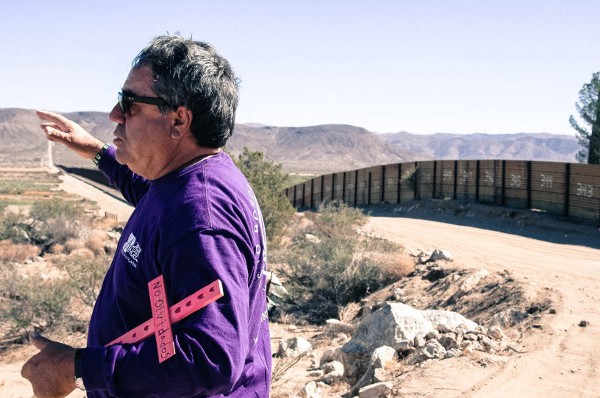
“Over here” was a brush-filled patch of the Jacumba desert, itself a thin stretch of dirt, low grass, and spindly shrubs about an hour and a half east of San Diego. The area was once the site of many illegal border crossings, as it runs alongside the physical wall representing the border between Mexico and the United States. ThinkProgress traveled to Jacumba with Morones to participate in a “water drop,” a practice where volunteers from his organization journey into the desert to leave out water bottles for migrants crossing the border. The water, Morones said, could save lives.
“They’ll hide out here for a long time at night,” he said, pointing to a small bush. He turned and mimicked the posture of someone hiding after jumping the fence. He held out his hands, as if lying prostrate in the dirt, and nodded in the direction of the Border agents above us. That, he explained, is when migrants, frightened and exhausted after a long trip, could use some water.
Americans are often presented with claims about how “easy” it is to cross the border from Mexico into the United States. In September of last year, Rep. Paul Gosar (R-AZ) declared that barbed wire was the “only thing” stopping migrants from crossing the border, claiming that terrorists could effortlessly enter the country through the southern border. Several other conservative politicians have made similar statements, all predicated on the idea that crossing from Mexico is a simple trip.
But these narratives stand in stark contrast to the hundreds of deaths that occur each year along America’s southern boundary, where immigrants, activists, and residents of divergent political persuasions report that crossing the U.S.-Mexico border is difficult, dangerous, and — all too often — deadly.
Heat and exhaustion
Morones explained the history of Border Angels and water drops as he guided ThinkProgress reporters across the desert. He gestured as he walked to direct us where to leave our jugs — usually underneath bushes and sand banks.
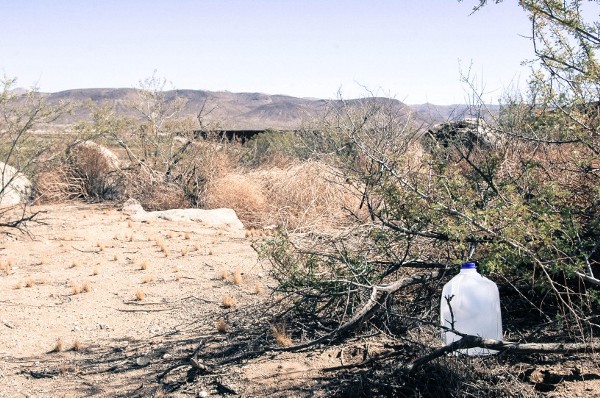
“When I started doing this in 1996, no one anticipated the deaths,” Morones said, referring to a time period in the mid-1990s when the federal government implemented the Southwest Border Strategy. The new immigration program shut down areas of the border where people normally cross, re-routing migration flows and ultimately leading to an increase in the number of border-crossing deaths from exposure to either extreme heat or cold, according to a report from the U.S. Government Accountability Office. Although the number of deaths has decreased in the San Diego region in recent years, U.S. Customs and Border Patrol reports that the number of people who have died crossing the U.S. border has increased overall.
Staring out across Jacumba, it was easy to see why the Border Angels — along with similar groups such as “Los Samaritanos,” or Samaritans, in Arizona — take their work so seriously. Although ThinkProgress visited Jacumba in early winter, it was still noticeably warm, and temperatures in the area can reach as high as 111 degrees in the summer months. Most sections of America’s southern border regularly report similar temperatures, and since immigrants often have to walk miles alone through the desert, the blistering sun can quickly cause dehydration, heat exhaustion, and even death.
Border-crossers try their best to be prepared for such conditions. True, immigrants typically don’t have much in the way of supplies, as they are are often beleaguered by crushing poverty in their home countries. But they are still wary of dangers lurking about the border, and bring along what little they can carry. The U.S. side of the wall in Jacumba was littered with things migrants have dropped along the way: ripped clothing, desiccated oranges, and muslin cloths that some tie underneath their shoes to help hide footprints from border officials. Peering through the border fence into Mexico, we could see several crumpled plastic water bottles — presumably discarded before crossing — stacked on top of the sand beneath a tangle of bushes.

Despite these precautions, few travelers make it across the desert unscathed. According to U.S. Customs and Border Protection, some 2,346 people had to be rescued along the border during the 2013 fiscal year, something Morones said is often a direct result of the blistering heat. Groups like Border Angels try their best to offer assistance, but their efforts aren’t nearly enough to cover the 1,954 miles that make up the U.S.-Mexico border.
“We didn’t have a name until 2001, when we were called the Border Angels,” Morones said, stepping gingerly as he spoke to avoid slipping on the loose sand. “There are now over 25 organizations that drop off water. We come out three or four times a month to various locations.”
If extreme temperatures weren’t enough, migrants also have to avoid dangerous creatures that roam the untamed borderlands. Snakes such as the western diamondback rattlesnake, whose bite can cause extreme pain and even death, hide under rocks and shrubs along the entirety of America’s southern border. In addition, the Southwestern section is home to the Arizona Bark Scorpion, whose sting can cause severe pain, numbness, vomiting, loss of breath, and even convulsions for up to 72 hours. The dangerous insect frequently seeks shelter in shoes, clothing, or sleeping bags — the few possessions often carried by border crossers.
Morones said he himself was once bitten by a Brown Recluse spider — one of the most venomous creatures in either country — during a routine water drop near the border a few years ago. He said the injury ravaged his hand, causing chunks of flesh to decay away until he visited a doctor. The wound finally began to heal several weeks later.
The incident was uncomfortable for Morones, but such a bite could be a death sentence for many migrants: medical experts and anti-venom are hard to come by in the desert, where a healthy body can mean the difference between life and death.
Human hazards
Even if a traveler is fortunate enough to beat the elements and escape nature’s wrath, there is still another, far more dangerous threat to evade: other humans.
Pausing for a moment during our walk across the Jacumba, Morones stooped to pick up an empty, broken water jug.
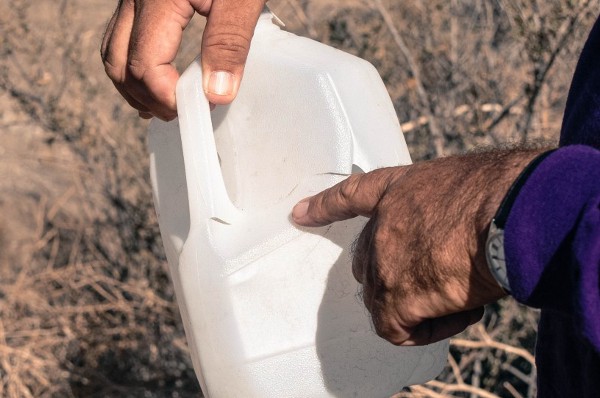
“These holes are from an animal, probably a coyote,” he said, holding up the jug and pointing to various tooth-sized punctures near the lid. He then drew his finger across a long, slender gash that stretched along the middle of the jug. “But this might be from something else — a knife. We find empty water bottles out here with gashes like this … Minutemen will come and slice them open.”
He added that people will sometimes write chilling messages on busted jugs, such as “kill these people.”
The so-called Minutemen, originally formed in 2005, are a loose collection of armed anti-immigration activists who see migrants as a threat to American society and regularly patrol the border looking to intercept crossers. Led by political activist James “Jim” Gilchrist and named after the Minutemen of the American Revolution, the group’s website says it is dedicated to “protecting” the border by running “volunteer scout patrols” and “offering assistance” to Border Patrol agents.
Although members of Minutemen groups have not yet been found guilty of committing violence against border crossers, their vehement anti-immigrant stance has caused clashes with immigrants and Hispanics living in the United States. In 2011, Shawna Forde, founder of Minutemen American Defense, was found guilty of breaking into the home of 29-year-old Raul Flores and murdering him and his 9-year-old daughter. Forde, who was given the death penalty, explained that she had planned to rob Flores to fund her militia group. She justified the act by saying that she thought Flores — who, like his daughter and wife, held American citizenship — was a drug dealer.
Minutemen activities have lulled over the years, but Gilchrist recently tried to rally thousands of vigilantes to capture the droves of Latin American children who came across the border this past year — a radical move that came with the blessing of some Texas state lawmakers. The Minutemen Project has since announced plans for its largest effort to date, a robust gathering of gun-toting anti-immigrant activists codenamed “Operation Normandy” scheduled for May 1, 2015 — the anniversary of the famous American invasion of France during World War II. Organizers plan to assemble thousands of armed individuals and “militias” along the border, where they will encourage participants to “make their stand” against any immigrants they see cross.

The Jacumba desert.
But while the Minutemen are currently more of an existential threat to migrants — their alleged sabotage of water supplies, if true, constitute an indirect attack on the livelihood of migrants — people crossing the border do face real violence at the hands of those who live along the wall. Ranchers often encounter immigrants crossing their land, for example, and some have been known to respond to trespassers with deadly force. In 2009, one rancher reportedly held 11 immigrants at gunpoint and threatened to set his dog loose on them, and another shot 2 men on his property in 2011 because he thought they were border crossers. Some ranchers have even organized teams of people to hunt for immigrants, although most insist their intention is only to stop them and alert Border Patrol, not hurt people.
Some ranchers, of course, leave out buckets of water for immigrants to drink as they make their way across the border. But even with good samaritans about, the odds are stacked against border crossers: On the Mexico side, Morones said that immigrants — particularly those coming from Central America — often solicit the help of human smugglers, many of whom are affiliated with notoriously violent Mexican gangs and criminal organizations. Although these guides, sometimes called coyotes, assist some migrants, they’re also known to hurt or even rape women they escort, and some simply abandon their clients altogether. Morones spoke of guides who “will say that they’re just walking [away for] a couple of hours” before leaving immigrants alone and desperate in the desert. This is corroborated by statements made by various U.S. Border Patrol agents, who note that these smugglers will often leave behind travelers who can’t keep up, dooming them to wander aimlessly across scorched wastelands with no direction or form of communication — a perilous situation that can easily lead to a lonely death.
Fighting for dignity, even in death
Because of this lethal combination of environmental and human dangers, more than 6,000 people have been found dead over the past 16 years attempting to enter the U.S. from Mexico, and some 307 met their end while crossing between October 2013 and September 2014 (that’s down from 445 the year before). In the 2013 fiscal year, Border Patrol recorded seven deaths in the San Diego sector alone.
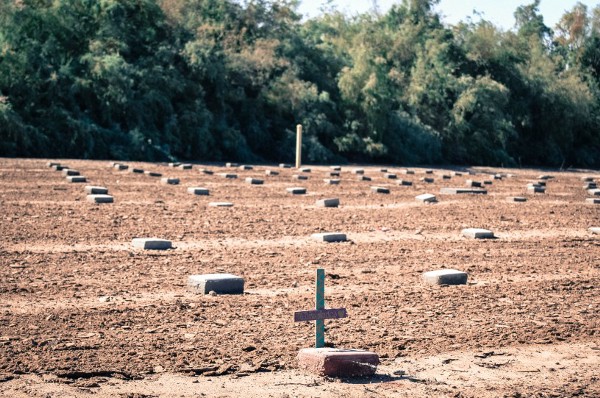
Still, exact counts of immigrant dead are often difficult to ascertain, both because statistics from the Mexico side are hard to acquire and because it’s not always clear who is or isn’t a migrant. This is especially evident at Terrace Park Cemetery, a county-run burial ground in Holtville, California, about an hour east of Jacumba. When ThinkProgress reporters visited the cemetery after finishing the water drop, we were greeted by Chuck Jernigan, a mustachioed, cigar-chewing former sheriff who now oversees the area as Superintendent of the Central Valley Cemetery District. Jumping out of his truck to walk us across the dirt field that constituted the graveyard, he explained that the cemetery primarily serves as the final resting place for poor individuals who can’t afford funerals.
“In the old days we used to call this a pauper’s field,” he said.
But closer inspection of the cemetery, which is home to 522 graves total, reveals a strange oddity: about half of the graves are marked with little more than a small, nondescript brick resting atop the ruddy red dirt, and while some have names, most are inscribed with just an identification number. This is because the yard also houses unidentified bodies found in Imperial County, and since the area is known to be a hotbed of border crossings, many of the nameless graves that fill the yard — listed as John or Jane Doe on official documents — are suspected to house the bodies of immigrants who passed away while trying to cross over.
The presence of possible immigrant graves has made the cemetery a flashpoint between immigrant rights activists and Jernigan. Morones and Border Angels volunteers insist the graveyard should be made more easily accessible so groups can visit and hold vigils for the people they claim are immigrants (the burial ground is usually only open to people who submit a written request two weeks ahead of time). But Jernigan argued that holding specific religious ceremonies for the unidentified graves is inappropriate because it is impossible to know their religious affiliations, and that allowing for unmitigated access to fresh graves could result in accidents.
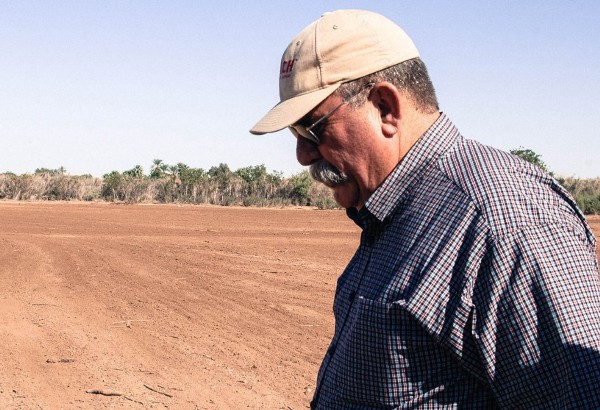
Despite this tension, Jernigan has allowed Border Angels and other groups to hold occasional vigils on the grounds, as evidenced by the row of tiny, colorful crosses — supplied by volunteers from Border Angels — that sit behind several graves. They read “No olvidados,” which means “not forgotten” in Spanish.
“We leave ’em up until the crosses fall down,” he said, implying that allowing the crosses was a concession, and not his personal preference.
For his part, Jernigan, a self-described “Fox News junkie,” expressed deep frustration with immigration activists such as Border Angels and Democrat-led efforts to overhaul the current immigration system. He noted, for instance, that it wouldn’t be “right” if undocumented immigrants currently living in the United States were granted citizenship or permanent residency en masse.
Yet he was also adamant that his job was simply to provide dignity to the deceased — whoever they may be — and was quick to distinguish between his irritation with the immigration system and immigrants themselves.
“My feelings about immigration don’t have anything to do with the business I’m in,” he said. “The majority [of immigrants] just want to come over and feed their family, and that’s not a crime … They’re good people. They’re honest people, man. They’re just looking to better themselves.”
The majority [of immigrants] just want to come over and feed their family, and that’s not a crime.
Unfortunately for immigrants, Jernigan’s passion for respectful burials is increasingly rare, and many who pass away while crossing the border still have to fight for dignity in death. For example, Jernigan noted Terrace Park actually hasn’t buried an unidentified body in four years, but not because people — or immigrants — have stopped dying. Imperial County still reported Jane and John Does deaths after 2010, but county officials told ThinkProgress that those bodies were cremated. If any of those bodies were Catholic immigrants, the use of cremation is potentially insulting; the Catholic Church lifted its ban on cremations in 1963, but still officially prefers a physical burial, as do many traditional Catholics. Yet the practice of cremating unidentified immigrant bodies is widespread, and various other counties along the Arizona border also cremate immigrant bodies.
But even cremation is preferable to the treatment awaiting some immigrants who don’t survive the trip. Last year, anthropologists uncovered a mass grave of immigrant bodies at a funeral home in Brooks County, Texas. One of the plots had three bodies stuffed inside a single body bag, another had the deceased wrapped in small garbage bags, and still others contained disembodied skulls and skeleton parts shoved into biohazard sacks. The county had reportedly been paying the funeral home to intern bodies for 16 years.
Deaths have been reduced at some parts of the border, but last year’s surge of people — including thousands of children — fleeing to the United States from violence-ridden Central American countries could lead to a uptick of newly reported deaths. Meanwhile, efforts to bolster border security — which the federal government already pumps around $18 billion into annually, more money than is spent on every other federal law enforcement agency combined — have yet to stop the dying.

Empty bottles left over from previous water drops.
Back in Jacumba, Morones told ThinkProgress that he plans to keep leading water drops for as long as it is needed, but expressed dismay about the perilous situation facing those who risk the trek to the United States. As he extrapolated on the death toll caused by the border and the wall, he was interrupted by the groan of a Border Patrol SUV, its tires kicking up clouds of coarse sand as it rumbled down the path that runs along the fence.
“You have a situation where people are dying — they’re dying everyday,” he said, watching it pass.
Esther Lee contributed to this report.
